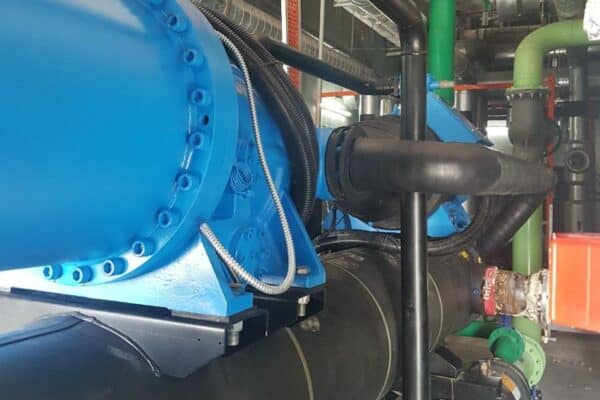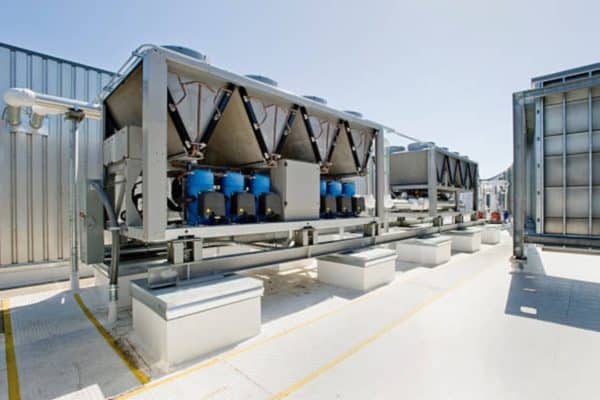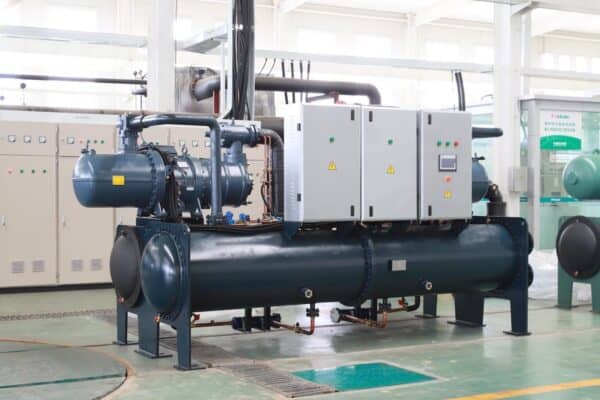5 Types of Chillers in HVAC (Capacity & Efficiency)
Chillers are one of the most important components in HVAC. They are the heart of the HVAC chilled water system. There are many types of chillers in HVAC and thus, what are the most common types of chillers in HVAC?
The 5 common types of chillers in HVAC are the centrifugal chiller, the air-cooled chiller, the hybrid chiller, the magnetic bearing chiller and the heat recovery chiller. Among them, the centrifugal chiller is the most common type of chiller in HVAC.
Most of the time, chillers are categorized as either water-cooled or air-cooled. Furthermore, a chiller can use different types of compressors such as the scroll compressor, the screw compressor and the centrifugal compressor.
Different types of chillers have very different characteristics. Because of that, chillers are often called by the combination of their categorization and the type of their compressor.
1. Centrifugal Chiller

Centrifugal chillers are the most common type of chiller in HVAC. Centrifugal chillers are mostly water-cooled. So, they are sometimes referred to as water-cooled centrifugal chillers.
Centrifugal chillers are always working with cooling towers due to the nature of water-cooled chillers. They use water to absorb heat in a building and reject it outside the building through cooling towers.
As the name suggests, centrifugal chillers use centrifugal compressors. Small capacity centrifugal chillers often use only a single compressor. Large-capacity centrifugal chillers usually have dual compressors.
Generally, centrifugal chillers are large in cooling capacity. The available cooling capacity of a typical centrifugal chiller can range from around 150 RT to around 4000 RT.
RT stands for refrigeration tonnage. One RT is equivalent to 12000 btu/hr.
Although centrifugal chillers can have a cooling capacity of as low as 150 RT, they are more commonly used in large buildings with a cooling capacity requirement of around 600 RT and above.
Centrifugal chillers themselves don’t have any fans. They usually have two shell-and-tube heat exchangers; one is for the evaporation process and the other one is for the condensation process.
Large centrifugal chillers have very good efficiency. A standard 1000 RT water-cooled centrifugal chiller usually has an efficiency of around 0.55 kW/ton.
kW/ton is an energy efficiency measurement unit for chillers and other large-capacity air conditioners. kW/ton stands for kilowatt per ton of refrigeration. If a 1000 RT chiller has an efficiency of 0.55 kW/ton, its power consumption is 0.55 x 1000 = 550 kW.
Centrifugal chillers are more commonly found in large buildings such as shopping malls, hotels and hospitals. They often require a large chiller plant room to contain. Besides, a large roof or open space is also needed for their associated cooling towers.
Because most centrifugal chillers have one or two large compressors, they are generally not suitable for low cooling load applications because their compressors are not able to reduce speed sufficiently.
2. Air-Cooled Chiller
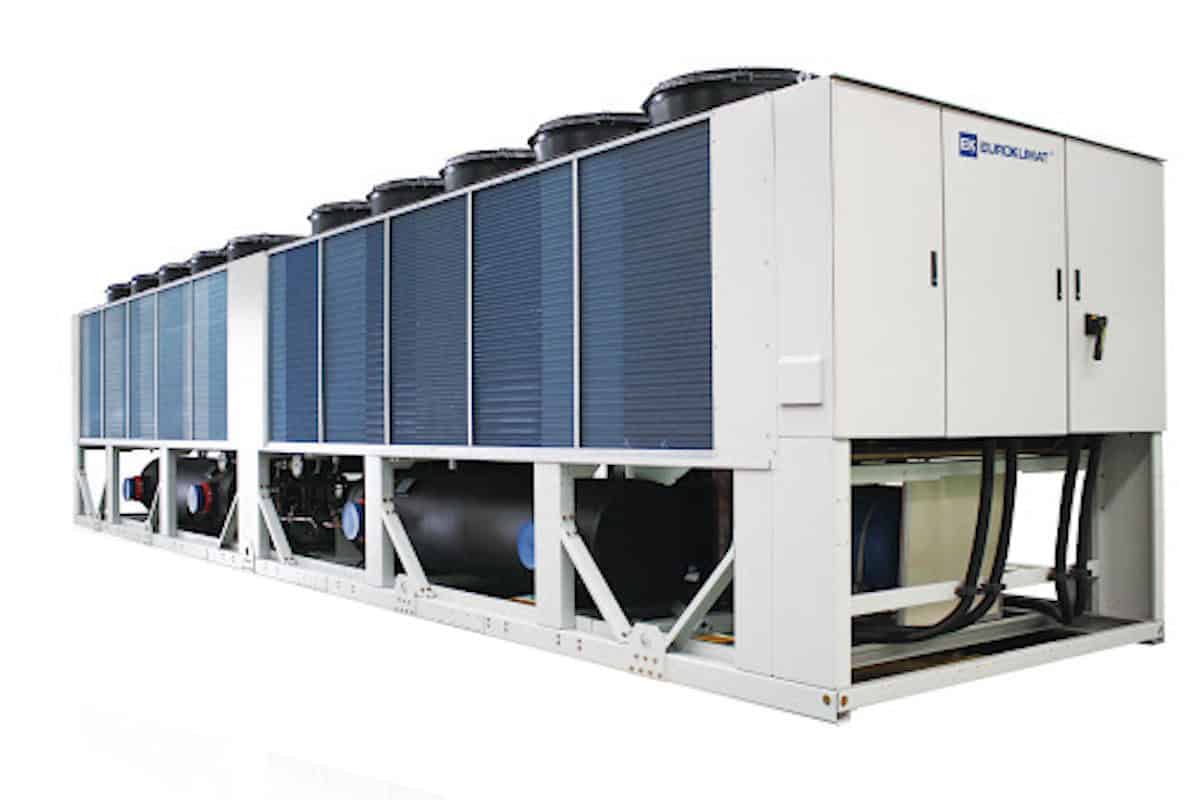
Air-cooled chillers usually have two fans that reject heat outside the building instead of relying on cooling towers. So, the overall space needed for systems with air-cooled chillers is smaller than systems with water-cooled chillers.
Most air-cooled chillers are either using scroll compressors or screw compressors. So far, there are no air-cooled chillers with centrifugal compressors.
Air-cooled chillers are generally simpler than water-cooled chillers. Sometimes, air-cooled chillers are also known as modular chillers because they can be stacked horizontally like legos to increase their total cooling capacity.
The available cooling capacity of a typical air-cooled chiller can range from around 10 RT to around 550 RT. With scroll compressors, a single air-cooled chiller may be designed with a maximum cooling capacity of around 200 RT. But, with screw compressors, a single air-cooled chiller can go up to 550 RT of cooling capacity.
Usually, an air-cooled chiller has at least two compressors. If one compressor is malfunctions, the other compressor can continue to operate with the total cooling capacity of the chiller being at 50% only.
Air-cooled chillers are not as efficient as water-cooled chillers. Their energy efficiency is at around 1.00 kW/ton only. Hence, water-cooled chillers are twice as efficient as air-cooled chillers.
The main advantage of air-cooled chillers over water-cooled chillers is that air-cooled chillers are much better at handling low cooling load applications because they have smaller compressors that can switch on and off much more frequently and effectively.
Although air-cooled chillers may seem to occupy less space than water-cooled chillers, they may occupy much more space than water-cooled chillers when used for large cooling capacity applications due to the sheer amount of chiller quantity.
On a side note, if you want to quickly learn about chilled water system, you can get my Chilled Water System (eBook). If you’re into design, you can enroll in my Chilled Water System Design Course where I teach you various design procedures with tons of examples.
Chilled Water System Design Course
Learn how to design a chilled water system with AHU/FCU selection, chiller sizing, cooling tower sizing, pump sizing, piping design, ductwork design and more.
3. Hybrid Chiller
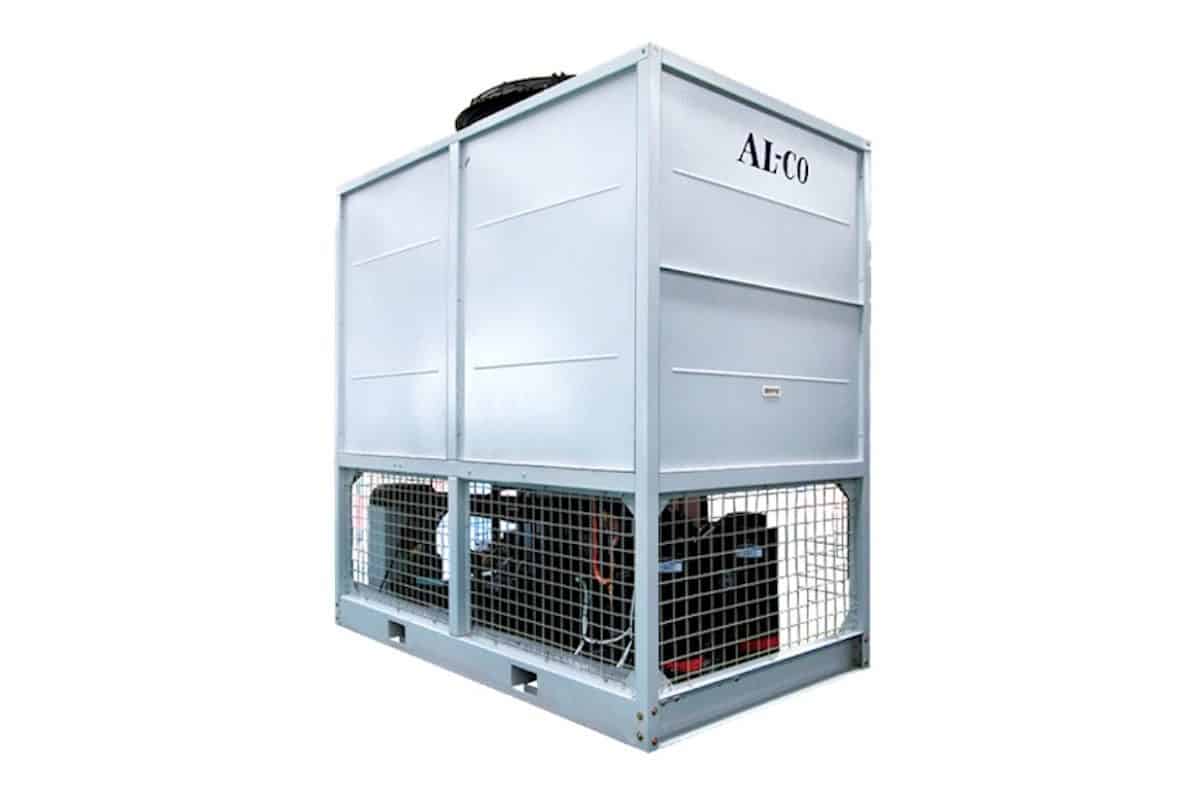
A hybrid chiller is sort of a combination of an air-cooled chiller and a cooling tower. Hybrid chillers use the principle of evaporative cooling to help with heat rejection in addition to their own fans.
See my blog post about hybrid chillers working principle.
Similar to air-cooled chillers, hybrid chillers usually have two fans and one finned-tube heat exchanger for heat rejection as well as one brazed plate heat exchanger for chilled water production.
However, unlike air-cooled chillers, hybrid chillers also have an additional water circulation pump and internal pipes with nozzles so that they can spray water onto their infills or heat exchangers to better reject the heat.
Therefore, hybrid chillers are slightly more efficient than air-cooled chillers but still, they are less efficient than water-cooled chillers. Most of the time, hybrid chillers have an efficiency of around 0.75 kW/ton.
Due to the nature of evaporative cooling, the performance of hybrid chillers is dependent on the outdoor wet-bulb temperature. In other words, hybrid chillers perform better in low humidity places.
Learn in detail on chiller performance from my blog post about the effect of different chilled water temperature.
The main disadvantage of hybrid chillers is that the heat exchanger of hybrid chillers often requires to be made of materials that withstand corrosions because water is constantly poured onto the heat exchanger as well as the hybrid chillers are exposed to the weather.
Therefore, many hybrid chillers by default are required to use stainless steel material for their casing and heat exchanger. With stainless steel material, they are much more expensive than both air-cooled chillers and water-cooled chillers.
Most hybrid chillers also have two compressors like air-cooled chillers do. They can operate at 50% capacity if one of the compressors is malfunctions. However, in large cooling capacity applications, they quickly become very difficult to be serviced and maintained due to the sheer amount of chiller quantity.
4. Magnetic Bearing Chiller
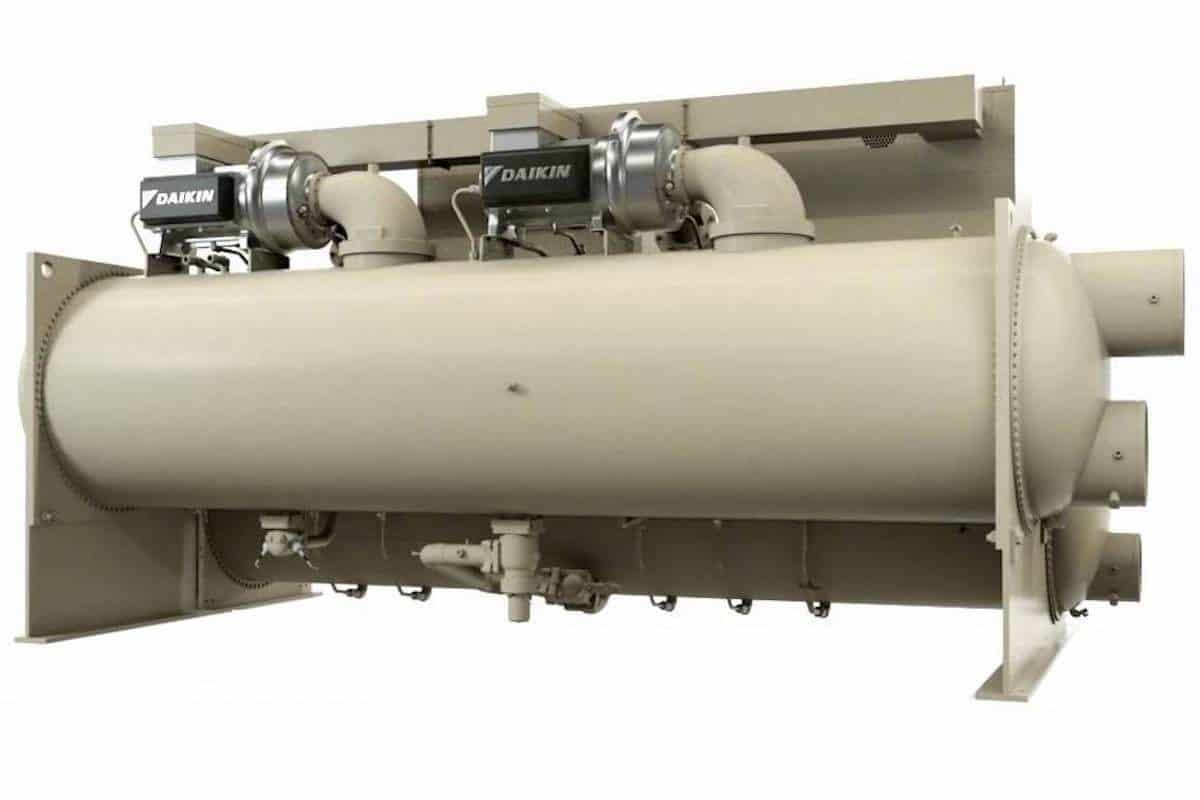
Magnetic bearing chillers are mostly water-cooled centrifugal chillers. Standard centrifugal chillers use lubricant for their centrifugal compressors. However, magnetic bearing centrifugal chillers don’t require any lubricant. Thus, they are also known as oil-free chillers.
Water-cooled centrifugal chillers with magnetic bearing compressors are relatively new. The most popular magnetic bearing compressors or oil-free compressors are made by Danfoss called Turbocor.
However, nowadays many chiller manufacturers are producing their own version of oil-free compressors for their magnetic bearing centrifugal chillers.
Because magnetic bearing chillers have very low friction loss at their compressors, they tend to have very high efficiency, higher than standard water-cooled centrifugal chillers. So far, the most efficient type of chiller in HVAC is the oil-free magnetic bearing water-cooled centrifugal chiller.
Some magnetic bearing chillers are about 40% more efficient than standard centrifugal chillers. In addition, magnetic bearing chillers offer lower noise operation than standard centrifugal chillers. Besides, they require less maintenance.
As of writing, the maximum cooling capacity of some of the largest magnetic bearing chillers is around 1500 RT only. However, magnetic bearing chillers can go down to as low as 60 RT.
5. Heat Recovery Chiller
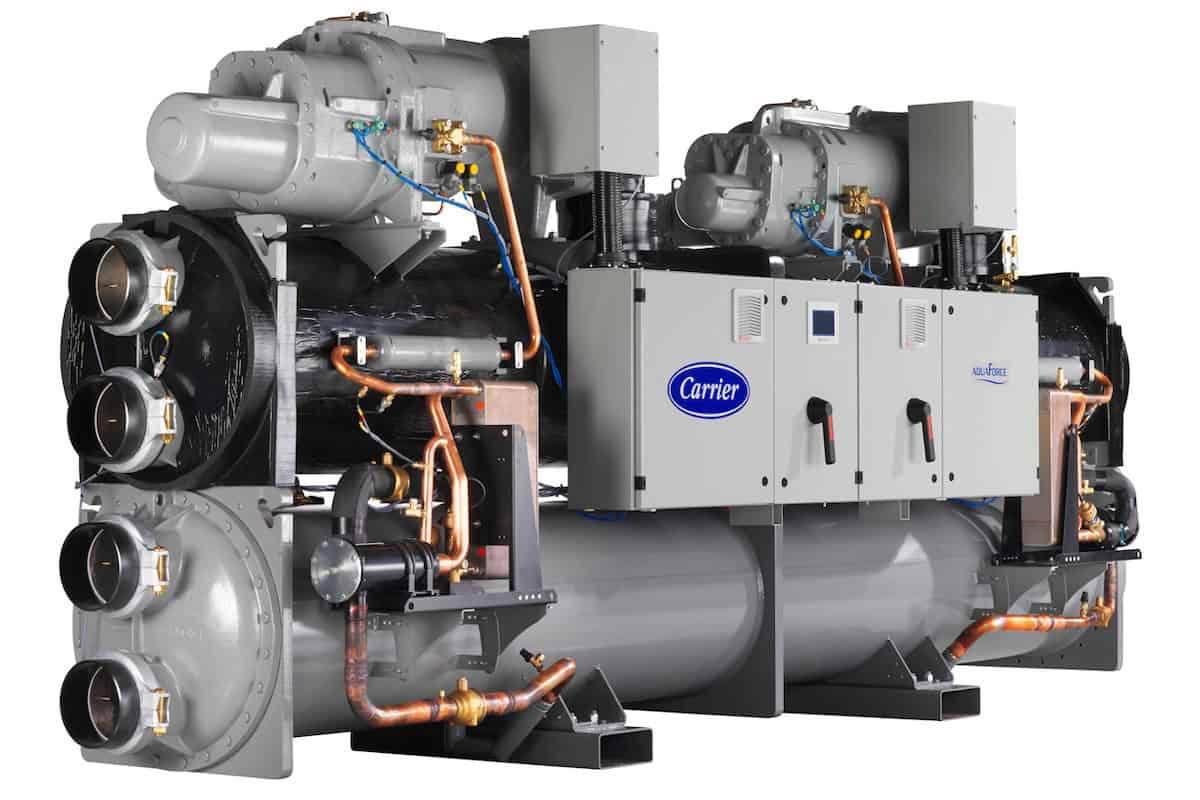
Heat recovery chillers are able to produce chilled water for cooling and hot water for various purposes at the same time. The heat absorbed by the condenser water doesn’t get wasted at cooling towers. Instead, it is used to produce hot water.
More about hot water system in my blog post on hot water heat pump basics.
Heat recovery chillers are also known as heat reclaim chillers. Heat recovery chillers are mostly water-cooled type and their compressors are screw type.
Heat recovery is a function that is available for both air-cooled chillers and water-cooled chillers. Usually, heat recovery chillers are bigger in physical size because they have an additional condenser (shell-and-tube heat exchanger) for the heat recovery process.
Many heat recovery chillers are able to harvest the heat from their condenser and produce hot water at around 60°C which is the standard hot water storage temperature.
With an additional function, heat recovery chillers have better efficiency than standard centrifugal chillers. Some heat recovery chillers claim to have an efficiency of as low as 0.50 kW/ton or less. However, they don’t seem to beat magnetic bearing chillers now.
In a typical chilled water system, out of 5 chillers, only one chiller has the heat recovery function most of the time because the hot water demand is not as high as the demand for cooling. However, it is still depending on the applications.
Nevertheless, heat recovery chillers do reuse heat that otherwise will be wasted to produce useful hot water. Hence, they are considered as green technology in HVAC.
Once again, you can get my Chilled Water System (eBook) to quickly learn more about chilled water system. But, if you want to learn how to design a chilled water system from start to end, I encourage you check out my Chilled Water System Design Course.
Chilled Water System Design Course
Learn how to design a chilled water system with AHU/FCU selection, chiller sizing, cooling tower sizing, pump sizing, piping design, ductwork design and more.
If you have anything to add (or ask) about this topic, leave a comment down below!



